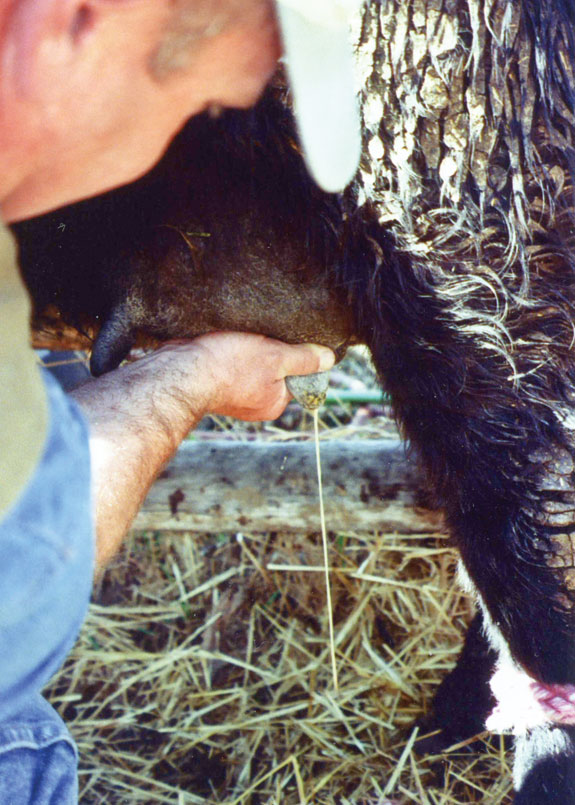
It may also occur if the udder is bumped and bruised; damaged tissue creates ideal conditions for infection. A big quarter that hasn’t been nursed can be easily bruised.
If a teat is dirty from mud or manure, the calf may refuse to nurse that quarter. Whenever the teat orifice is not tightly closed (as when a large quarter is leaking milk), it may be at risk for bacteria to enter.
Some cows are vulnerable to mastitis at weaning time when the udder is full. A full udder may become bruised if a cow runs up and down the fence trying to get back to her calf. An injured udder can become infected.
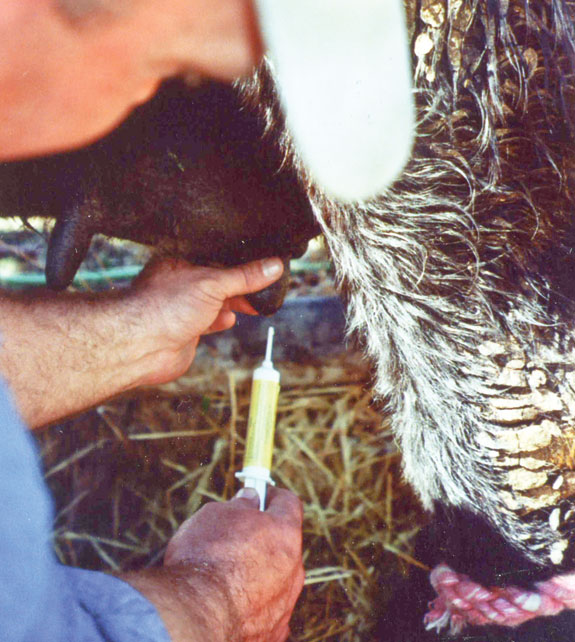
If infection stays localized, mammary tissue in that quarter may be destroyed but the infection is not life-threatening.
That quarter may be permanently damaged unless treated – it will dry up and be small and dry the next time she calves.
But if the infection gets into the bloodstream, the cow may become sick. She may go off her feed and have a fever. Unless treatment is swift and diligent, you may also lose the cow.
Dr. Shelie Laflin, clinical associate professor of agricultural practices at Kansas State University, says mastitis often occurs in beef cows that produce more milk than the calf can suckle.
“This can lead to the teat orifice remaining open and more vulnerable to environmental pathogens,” she says.
“We commonly see environmental pathogen mastitis in beef cows, whereas staph aureus infections occur more in dairy cows, transmitted by milking machines or by milkers’ hands.”
Dairy cows are more prone to mastitis because of the larger mammary gland and the way their udders are frequently handled.
“Automatic milkers cause the teat orifice to open, and the teats are also handled by humans – exposed to more pathogens than you’d find in a calf’s mouth,” she says.
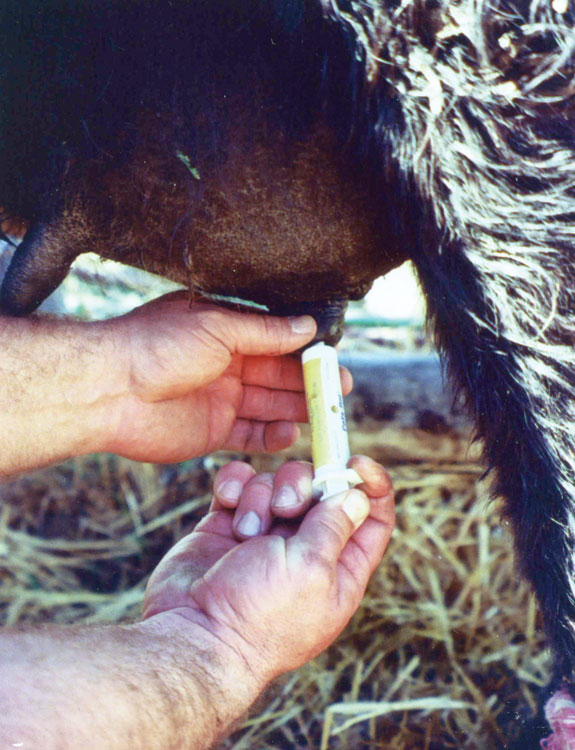
Dr. W. Mark Hilton, clinical associate professor for beef production medicine at Purdue University, says acute cases in beef cows sometimes occur soon after calving.
“This problem tends to occur in older cows that are high producers,” says Hilton. “Predisposing factors include rainy, wet weather where cows lie in mud and manure or dirty bedding.
It’s less common when cows calve in dry weather, out on clean pasture – not confined in dirty calving areas or in a barn in February.”
He says most cases are subclinical and you likely won’t notice them. These cows generally get better on their own, but might lose milk production from that quarter due to scar tissue.
A cow with three quarters will give almost as much milk as a cow with four, however, because the other three compensate. The calf nurses more often, and this stimulates those quarters to produce more milk.
Older cows with large, pendulous udders are most at risk for bruising, injury or damage that might result in mastitis.
It’s also harder for their newborn calves to get on a teat. Producers should look closely at udder conformation and milk production when making culling decisions or keeping heifers.
Don’t keep a heifer from a cow with a bad udder or from a bull whose daughters have poor udder quality. If your herd already milks well, choose a bull with lower instead of higher EPDs for milk production.
The average beef cow today gives a lot of milk. Some give too much. “Beef producers have been selecting for more milk and this can get you into trouble,” says Hilton.
During the past 20 years, for instance, milk EPDs for Angus have gone up 20 pounds.
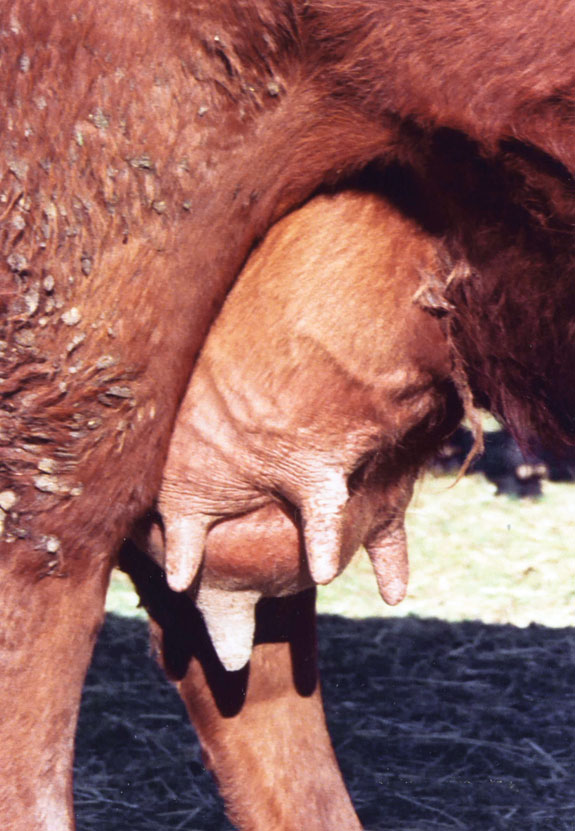
Treatment
If a beef cow gets mastitis, you can use intramammary treatments for dairy cows (infusing antibiotic directly into the teat canal).
“The challenging thing is that this requires multiple treatments, along with keeping that quarter empty – milking it out twice a day and then infusing the medication,” says Laflin.
Some infections are much more serious than others and you’ll need help from your veterinarian in treating the cow.
“Certain pathogens, like Archanobacter pyogenes, cause an abscessing mastitis, and often the best strategy is to destroy that quarter and let it drain so it can heal,” she says. The cow loses that quarter, but you save the udder.
“Some cows become severely ill very quickly,” says Hilton. You need to know if it’s just a localized infection or systemic.
He says every producer needs a digital thermometer and tells his clients to take the temperature of the animal before they call him to describe symptoms.
“Sometimes, when my clients describe the case, I can tell them what to do for it, or I may tell them I need to look at the cow,” says Hilton.
“When you milk out that quarter, you could tell the veterinarian whether the milk is watery or chunky, and what it smells like. From your description the veterinarian might recommend a certain antibiotic.”
If a quarter is just hard, hot and/or sore, and the cow won’t let the calf suck, she needs treatment with intramammary medications.
“This may require keeping her penned up where you can catch and treat her twice a day for several days,” says Laflin.
If she goes off feed, has a fever and is depressed, she needs more aggressive intervention. “This may mean putting her on systemic antibiotics and non-steroidal anti-inflammatory medication.
Some cows become so dehydrated and shocky that we also put them on IV fluids,” she says.
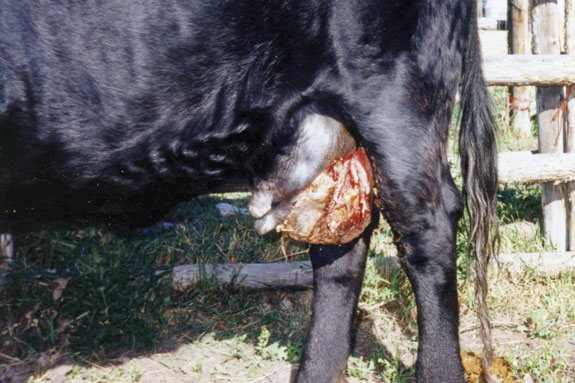
E. coli or Klebsiella can make the cow very sick very quickly. “You need to treat immediately with the appropriate antibiotics, because an aggressive pathogen may kill a cow in about 12 hours,” says Laflin.
“A rule of thumb when treating a cow: If she has clumpy milk or bloody milk and it doesn’t start to resolve within 12 hours after the first intramammary infusion, she should be examined by your veterinarian,” says Laflin.
“Early intervention could make the difference between her staying in your herd and weaning that calf or having to cull her (if the udder tissue must be amputated), or even losing her.”
If the milk was bloody and 12 hours later it’s just pink, that’s improvement. “You can continue the treatment you’ve been using.
But if it’s still bloody or clumpy, consult your vet. If the milk is watery or thin (serous), it’s a very aggressive pathogen and the cow needs immediate aggressive treatment,” she explains.
The affected quarter should be milked out as often as possible. If the calf will nurse it, that’s fine, but if she’s kicking him off because the quarter is sore, or he’s not nursing it because it tastes bad, you’ll have to milk it out. ![]()
An ounce of prevention …
Most of the time mastitis is due to a dirty environment, so the best prevention is calving at a time of year when teats and udders can stay clean.
Also make sure a cow doesn’t get chapped or damaged teats. If her udder hangs lower than normal, or teats are too big for the newborn calf to nurse readily, she may need attention.
“If another cow steps on her teat or it gets snagged in the brush or on a fence, the teat end may be damaged and it can’t close properly, and pathogens may enter,” says Laflin.
Chapped, frostbitten or sunburned teats may get so sore a cow won’t let her calf nurse, making her vulnerable to mastitis.
The end of a frostbitten teat may peel off, leaving the teat opening damaged. Monitor cows during adverse weather to make sure there are no udder problems.
A calf nursing in windy weather leaves the teat wet and prone to chapping and cracking, and teats may become sore.
The best way to prevent mastitis is to select cows with moderate rather than high milk production, and select for good udders (strong attachments so the udder sags) and short, small teats.
PHOTOS
Top Three photos: show treatment of a cow with mastitis – milking out the affected quarter, inserting a mastitis medication tube and squirting it up into the teat.
Bottom Middle: This picture shows a cow with a large, swollen quarter.
Bottom: An Angus cow is shown that lost part of her udder from a serious case of mastitis. Photos courtesy of Heather Smith Thomas.






